Venezuela and Its Calamities: Add COVID-19 to the List

Table of Contents
Author(s)
José Ricardo La Rosa
Former Latin America Energy Analyst, Center for Energy StudiesIntroduction
Despite its massive geological endowment and receiving what could be considered the largest windfall in its economic history, Venezuela entered this year still in the middle of an unprecedented economic crisis. The appearance of COVID-19 and turbulence in oil markets now represent the latest among a string of problems that expose the country’s vulnerability.
This You May Have Heard Of
The Venezuelan oil sector has long experienced dramatic changes in its operation. The country’s national oil company, PDVSA, lost financial and operational autonomy as the government extracted resources from its core business. Private partners faced conflicting relationships with the government, leading to lower profitability and private participation in investment projects. Further regulatory uncertainty and expropriation processes drove investors out of the country and many began legal processes against the State. Failed macroeconomic policies increased instability and distorted business conditions in the country. While the list extends to other political, economic, and sector-specific elements1 the consequence was that oil production (even according to official estimates) not only failed to double, as the government expected but has declined since 2005. The main drivers for this failure were the inability to materialize investments and the ever-increasing number of operational problems.
This decline only accelerated since the U.S. imposed economic sanctions. They initially targeted persons involved in human rights and political freedoms violations and later prohibited financial transactions related to PDVSA.2 In January 2019 PDVSA itself was designated as subject to sanctions blocking all types of commercial and financial operations with the company and its subsidiaries. PDVSA immediately lost access to its traditional export market: the U.S. Gulf Coast, where Venezuela exported 631 thousand barrels per day (kb/d) of crude oil and products to US refiners before this designation. PDVSA also lost its main source of light crude and refined products, affecting the processing of the Orinoco Oil Belt extra-heavy crude oil that requires diluents. Even though the U.S. granted licenses to operators like Chevron and service companies such as Halliburton, further restrictions were imposed last April that effectively prohibit operations such as drilling and commercializing crude oil and products, only allowing a “wind-down” period ending in December.
PDVSA attempted to circumvent these sanctions by turning to Asian buyers to replace its exports. Some estimates indicate that Reliance and Nayara were the only importers of Venezuelan crude in India in 2019, both buying around 337 kb/d.3 Other companies, like Chevron, Repsol, and ENI, also purchased Venezuelan oil only under temporary authorizations from the US government since the oil cargoes are used to compensate for unpaid debts and accrued dividends. The change in destinations and the increasing difficulties for trading crude and products from Venezuela led also to discounts in the export price compared to the situation before sanctions, and the compensation for previous debt commitments also implied that the share of export revenues for the country decreased. Moreover, the inability to find buyers for the entire daily production implied an increased use of local storage for this excess supply.
The Russian company Rosneft took an incredibly significant role in Venezuela’s oil industry as the availability of trading partners for the Venezuelan oil became critical for PDVSA. In this sense, during 2019, the Russian company controlled most international trading operations of Venezuelan crude oil, often working as an intermediary selling Venezuelan crude to refineries in China and India. The Treasury Department argues that Rosneft traded 55 million barrels of Venezuelan oil between September and December 2019.4
Pressure from the U.S. increased in August 2019 with Executive Order 13884 authorizing financial sanctions on non-US persons and companies, raising the prospect of “secondary sanctions” targeting foreign energy firms working with PDVSA. Some international companies severed their relationship with PDVSA in response. CNPC decided to stop direct purchases of Venezuelan oil,5 while companies like Reliance suspended purchases of Venezuelan oil while it seeks legal clarifications. On February 18 of this year, the Department of the Treasury enacted secondary sanctions against two Rosneft subsidiaries: Rosneft Trading (February), and TNK Trading (March), for their involvement in operations relating Venezuelan crude. After this, Rosneft canceled plans to load three ships with Venezuelan oil and, later, announced that it was selling its participation in Venezuelan projects to a new state-owned Russian company6. However, there are not signs of distancing between the two countries, according to both Russian officials7 and Maduro’s government8.
More recent attempts from PDVSA to commercialize their crude involved a group of Mexican companies in exchange for food and basic supplies,9 but they have also been frustrated by open criminal investigations from Mexican and U.S. authorities10 and the bankruptcy of one of these companies. Uncertainty about the volume and end customers for these exports has increased, given the continued use of ship-to-ship transfers to prevent tracing back the origin of the traded crude.11 Recent news reports,12 citing secondary sources and internal PDVSA documents, indicate that May exports fell to their lowest level since the general strike from December 2002.
As this “cat and mouse” dynamic between the U.S. and the Maduro regime continues to unfold, there is now a greater risk for companies to engage in business with PDVSA. They will not only be less willing to offtake Venezuelan oil cargoes, but they will also demand steeper discounts per barrel as long as this pressure continues.
Now Comes COVID-19
The problems associated with years of declining production, failed policies for the oil sector, and economic sanctions have represented enormous challenges for Venezuela, even without the prospect of oil demand problems. The year 2020 has provided additional challenges to an already troublesome outlook.
First, the regulations from the International Maritime Organization (IMO), preventing the use of High-Sulphur Fuel Oil in tankers, were put in place in January. This poses a problem for heavy-crude grades such as Merey-16 as it translates in further price discounts, whether or not tankers or refineries decide to retrofit their capacity to accommodate this supply in the future.
Figure 1 — Evolution of Merey-16 Prices
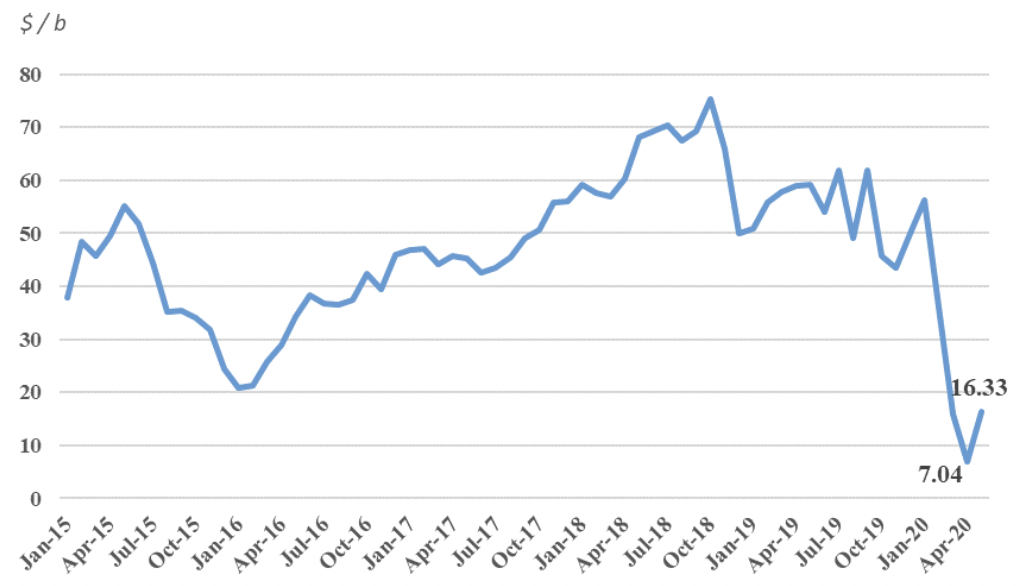
The biggest threat, however, comes from the economic impacts of COVID-19 and the containment policies adopted worldwide. As industry activity and transportation reduce their oil consumption, the International Energy Agency estimates that the year on year drop in global demand could be of 9.3 million barrels per day (Mb/d) in 2020, with most of the drop in the second quarter.13 The effect on prices from the spread of COVID-19 worldwide compounded when Saudi Arabia launched an oil price war in March 2020. This effect, combined with the discounts the Venezuelan crude already experienced, led to Merey prices to reach $7 per barrel ($/b) during April, according to reports to the OPEC (see Figure 1).
To get a sense of the impact on Venezuelan production in the short-run, we have to take a look at the cost of supply, dictated by its operating costs, and also what happens to local storage capacity, as the current market conditions and the challenges imposed by sanctions to commercialize production limit the ability to move production.
Figure 2 — Cost of Supply Heavy and Extra-Heavy Crude
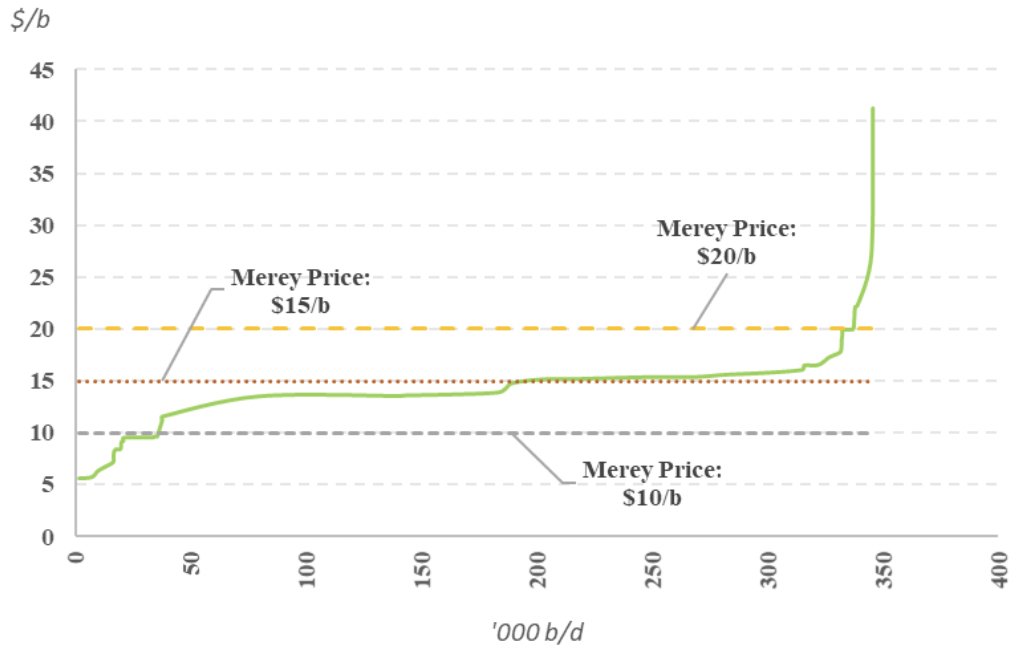
Consider the cost curve for heavy and extra-heavy grades in Figure 2, and light and medium grades in Figure 3. We see that a scenario of $15/b for the Merey-16 grade implies a drop of almost 160 kb/d in the production of heavy and extra-heavy crude oil. The impact is relatively smaller for light and medium crudes if we assume a scenario of $25/b, consistent with a Venezuelan basket of approximately $20/b. In this case, the drop is approximately 50 kb/d. Notice that according to this estimations, more than 85% of the production of heavy and extra-heavy crude oil would have an operating cost between $10/b and $20/b, so that prices of Merey-16 below $10/b could lead to a drop in production of more than 300 kb/d, close to 40% of the estimated production by Rystad at the start of 2020. The negative effects on production have also been recognized by Nicolas Maduro in some of his recent statements.14 We also have to consider that prices that allow a full cost recovery are significantly higher than those determined by these short-run considerations. Both royalties (set at 33.33%) and a minimum tax of 50% of all revenues significantly increase the break-even price.
Figure 3 — Cost of Supply Light and Medium Crude
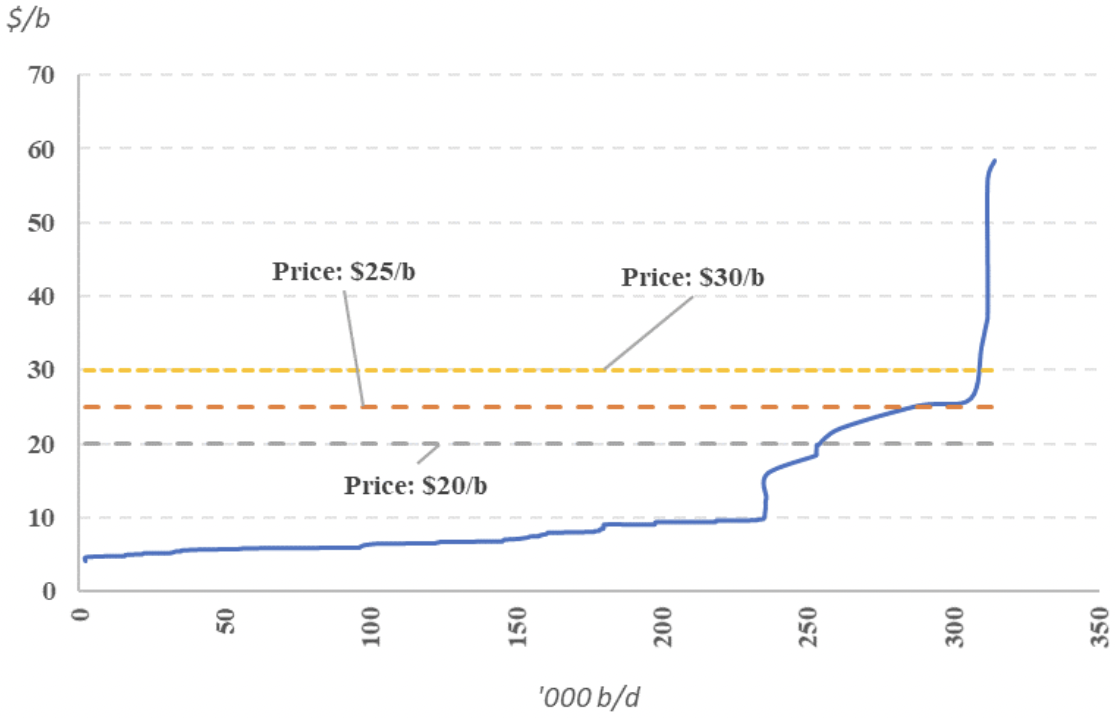
Notice also that considering transportation costs to Asian destinations implies that the alternative to the upcoming production is the use of storage facilities. However, given that in the last year sanctions severely limited market opportunities for Venezuelan production, PDVSA has resorted to direct this excess supply into storage. This means that now Venezuela is close to using its available storage capacity. The country reportedly can store around 40 million barrels of oil between domestic tanks and floating storage; by early March it had already accumulated about 35 million barrels of oil.15 PDVSA recently has resorted to including higher discounts to its production and sent oil shipments to Cuba, as to maintain room in inventories.
Figure 4 — Venezuelan Oil Production
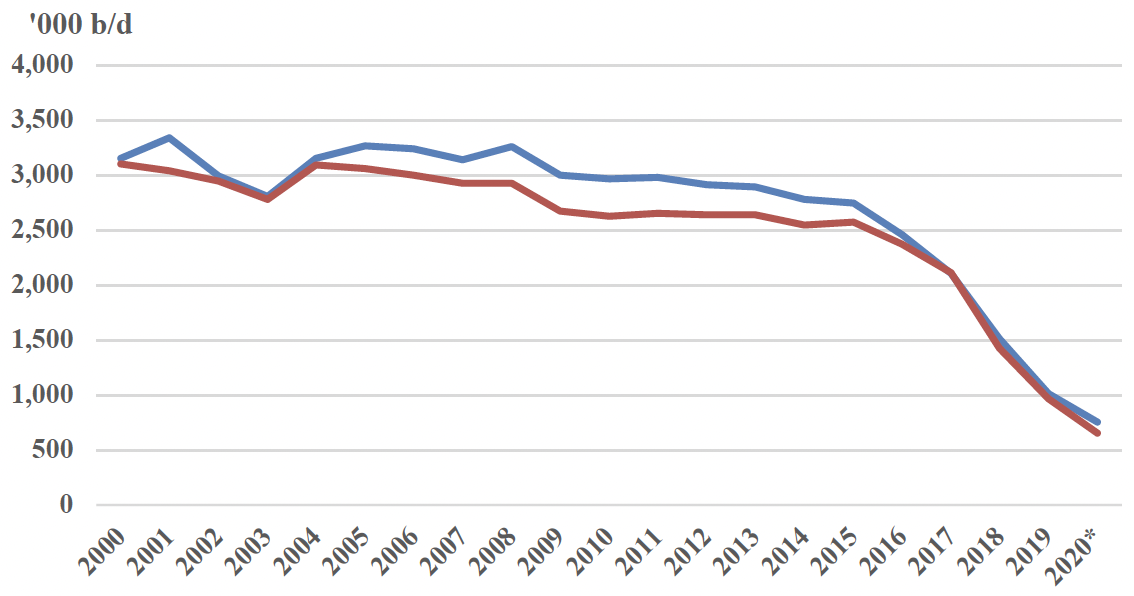
Note * Average YTD to May 2020.
The combined effect of years of underinvestment, the decline in oil prices, mismanagement, and operational problems and economic sanctions, among other factors, has led to a dramatic collapse in oil production (see Figure 4). Venezuela officially reports production of 570 kb/d in May, the lowest level since the 1940s, while production per capita on average during 2020 is currently at levels not seen since 1926 (see Figure 5). The inability to find new buyers and trading partners at a pace that absorbs current production, along with constraints in storage capacity, have become key determinants of Venezuela’s oil output in the short run.16 The combination of lower prices and volume will severely impact revenues for 2020. A local consulting firm estimates the number of cash-flow generating barrels at 260 kb/d on average for the year 2020;17 total revenues from oil exports could be as low as US$ 1.5 billion.18 In 2012, total oil exports reached US$ 93.5 billion, according to the Central Bank.
Venezuela’s Domestic Market
Figure 5 — Venezuelan Oil Production per Capita
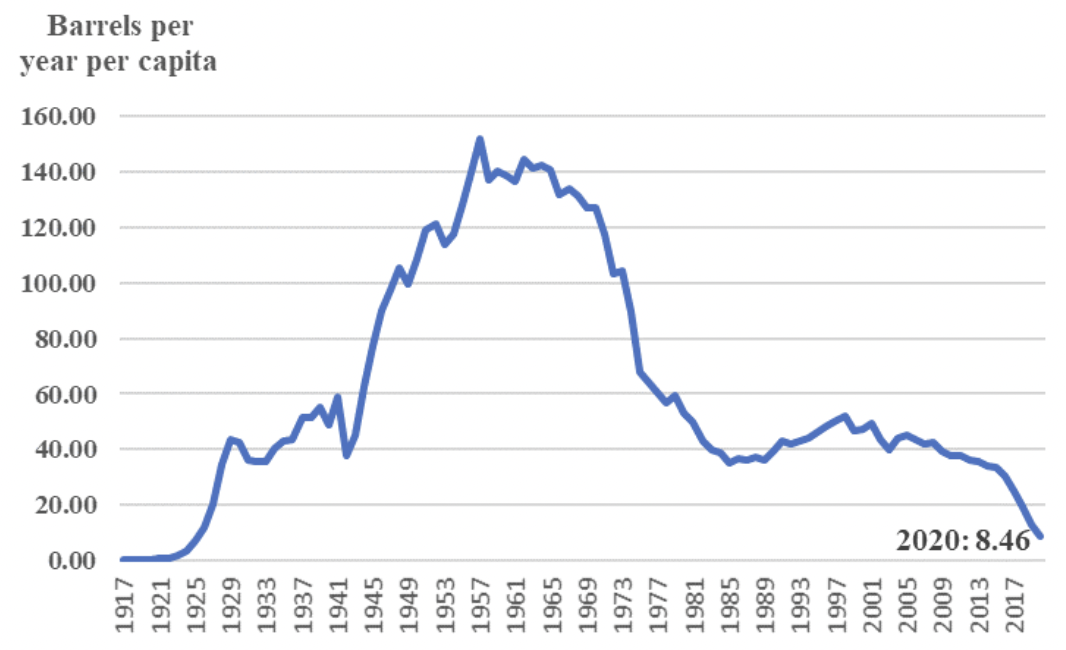
The problems of underinvestment, management, and operation of facilities go beyond the upstream segment of the value chain. The country now faces the threat of COVID-19 with the disruptions associated with the rapid decline in fuel supply in the country. While the country’s economic collapse reduced transportation and gasoline consumption, the local supply of fuels has also contracted. Recent estimates point to gasoline consumption has reduced to 110 kb/d,19 down from approximately 300 kb/d in 2012.
Even with dwindling demand, the local supply of gasoline has experienced a bigger decline. PDVSA has not revealed operational data since 2016, but independent estimates placed gasoline output from refineries as low as 30 kb/d in recent months.20 Problems with equipment replacement (leading to cannibalization or use of parts from other refineries), missing components for blending, lost hours due to accidents, among other events, substantially decimated the operation of refineries. In the absence of public data, independent estimates have capacity utilization for local refinery system around 10-30% over the last three years. Lack of fuel price adjustments in recent years also truncated any possibility to recover any operational and maintenance costs. In May, gasoline prices were still below 1 cent per liter.
PDVSA tried to compensate for the decrease in local fuel supply with imports, first from the U.S. and, after the enforcement of sanctions, through trading arrangements with multiple international companies, most notably Rosneft, which handled approximately 60 kbd of gasoline imports as of November 2019, according to Ministry of Petroleum figures in news reports. The sanctions to Rosneft trading drastically removed the gasoline supply, which combined with the depletion in inventories, led to a situation where approximately 90% of vehicles were affected by the shortage, less than 90 out of almost 1,400 stations were open21 and black market prices for gasoline reached $5.67 per liter in some parts of the country.22 As in the case of crude exports, reports also reveal increasing pressure from the US on international companies to limit or cease further operations with PDVSA that include gasoline imports.23 In response, the Maduro government has looked for support from Iran on several fronts: gasoline supplies, with initial shipments arriving at the end of May, as well as components such as alkylates for the operation of some of the local refineries. Also, they provide collaboration with Chinese technicians to perform repair work in several of the refinery units in Paraguaná to partially. It is not clear the extent or for how long the Iranian assistance will continue, as well as the compensation for this assistance from the Venezuelan government.
As the first cases of COVID-19 were reported, the government implemented shut-down policies that further reduced gasoline and electricity consumption, but as the gasoline supply further dwindled, additional measures were taken. These measures included an increase in gasoline prices, based on a two-tier system, at approximately 2.5 cents/liter for consumption up to 120 liters per month, and $0.5/liter for any excess consumption. It also allowed private contractors to import and supply gasoline (although PDVSA has already announced it will take over several gas stations operated by private owners, under unknown reasons)24.
Despite these actions, some questions persist. Even though news reports mention an increase of 40 kb/d in gasoline output from local refineries,25 there are doubts regarding the refinery repairs, given the accumulated damage across units over the years, lack of blendstocks such as alkylates, and technological incompatibilities, as the catalysts used in CRP were proprietary technology from the U.S., for example.26
Continued disruptions in gasoline supply present problems for critical supply chains, such as the case of the food industry, due to the inability to take production from the Western areas of the country to the main markets, which ultimately disrupts the harvest process, and could manifest in further food scarcity in coming months. For example, some estimates indicate that corn production will only be able to satisfy a quarter of the demand for 2020.27 Even oil production could be affected by the problems workers experience in getting to operation areas.
It’s Not Just the Oil Sector
As revenue sources falter and the country paralyzes due to fuel shortage, other risks still loom on the horizon. The reduction in activity in the oil and gas sector has also constrained significantly the availability from natural gas liquids coming from the associated gas in Eastern fields, which has further restricted the supply of propane for cooking gas, used by about 90% of the population.28 After a year of massive blackouts across the country, there are still concerns about the transmission infrastructure that handles 80% of the country’s electricity.29 Thermoelectric generation has also declined from the already low levels from last year, making the system more dependent on hydroelectric plants and weather fluctuations. This makes the country especially vulnerable to the health crisis associated with COVID-19 because, in addition to water supply problems and a crumbling health system, the electricity supply has become unreliable. A National Hospital Survey from several institutions, including the National Assembly, revealed that last year that on average, 57.3% of hospitals experienced power outages, while the average number of days without electricity was close to 15 every month.30 The overall economic situation also weighs against containment measures, as the population depends on daily income for their subsistence, in a country where the cumulative inflation through the first five months of 2020 was over 295%.
The ability to handle future cases of COVID-19 (and the rest of healthcare issues the population faces) could remain impaired by these types of issues. In June, the number of registered cases surpassed 4,000, with a substantial portion coming from states traditionally known for its oil activity, such as Zulia, where several hospitals are already overrun with patients and public service conditions are at their minimum.31
Looking Ahead?
As the myriad of problems that Venezuela faces continue to develop, social and political stability questions remain for the future. Local NGOs estimate over 1,000 protests across the country in May, most of them related to scarce public services: electricity, water, and cooking gas.32
While it is clear that the success of any economic reform in the oil and gas sector depends on a resolution of the political crisis, it is also very likely that the extent of the reforms is a function of the political outcome. Nicolas Maduro recently appointed a commission to restructure PDVSA and increase oil production. The commission recommended introducing a more flexible framework for upstream activities aimed at attracting private investments, reversing decades of overwhelming state control. Any prospect of successfully implementing such reforms, however, is severely impaired by the pressure of economic sanctions which will remain in place as long as Maduro stays in power,33 based on announcements by the Trump administration.
On the other hand, the opposition has coalesced around the need for private investment to recover the hydrocarbons sector, proposing a plan calling for $99 billion in capital expenditures and $64 billion in operating expenditures to increase oil production to 3 Mb/d in 8 years.34 Two projects are being discussed in the National Assembly: one is a new Hydrocarbons Law promoting significant reforms in the industry’s institutional framework, increasing the variety of business models and allocation mechanisms, and unifying the legal framework applicable to oil and gas activities, among other reforms.35 The second project is a more modest reform of the existing hydrocarbons law, aimed at providing equity and operational control to private partners, reducing the fiscal take for the existing projects, and allowing specific models such as service contracts. This reform may be easier to approve in the short term,36 while a consensus is being built around the more comprehensive changes proposed by the new Hydrocarbons Law. Both initiatives, however, can only be implemented under a new government, as PDVSA operations in the country are still controlled by the Maduro regime. As the industry further deteriorates, investment requirements may become larger or goals will have to be scaled back.
Even in a transition scenario, the implementation of these reforms will depend on the type of coalitions and the balance of power across interest groups. This poses another level of uncertainty due to conflicting interests of military groups, incumbent companies (including those of China and Russia), political parties, and potential investors. Aligning the interests of all groups toward a sustainable reform will be challenging – political compromise may trump the more aggressive changes. Moreover, Venezuela will also need to deal with the long term uncertainty in oil demand, changing strategies by international oil and gas companies, and the burden imposed by the expropriation process from the last decade as the country will need to regain the trust from private capital.
As the problems associated with COVID-19 stay in the country, and the political deadlock stands, future months will provide yet more problems for its population. Any economic recovery in Venezuela will rely on the oil and gas industry. But the scale of reforms required to attract investment dictates not only a shared vision for the sector but also an honest revision of paradigms about the role of hydrocarbons and energy in the country.
Endnotes
1. See Monaldi, Hernández and La Rosa, “The collapse of the Venezuelan oil industry: The role of above-ground risks limiting FDI”, February 24th, 2020 https://www.bakerinstitute.org/research/collapse-venezuelan-oil-industry-role-above-ground-risks-limiting-fdi/ . Also, Monaldi, “The collapse of the Venezuelan oil industry and its global consequences” March 9th, 2018. https://www.atlanticcouncil.org/in-depth-research-reports/report/the-collapse-of-the-venezuelan-oil-industry-and-its-global-consequences/.
2. Igor Hernandez, “Venezuela and U.S. Sanctions: Some Considerations,” IAEE Energy Forum, 2018, 9–12.
3. Sambit Mohanty and Ada Taib, “From Iraq to Canada: Venezuela vacuum intensifies India's heavy crude search,” Platts, March 6, 2020, https://www.spglobal.com/platts/en/market-insights/latest-news/oil/030620-from-iraq-to-canada-venezuela-vacuum-intensifies-indias-heavy-crude-search.
4. US Department of the Treasury, “Treasury Targets Russian Oil Brokerage Firm for Supporting Illegitimate Maduro Regime,” February 18, 2020, https://home.treasury.gov/news/press-releases/sm909.
5. Oceana Zhou et al., “APPEC: PetroChina to suspend direct imports of Venezuelan crude but China has other options ,” Platts, September 13, 2019, https://www.spglobal.com/platts/en/market-insights/latest-news/oil/091319-appec-petrochina-to-suspend-direct-imports-of-venezuelan-crude-but-china-has-other-options.
6. Gabrielle Tétrault-Farber and Olesya Astakhova, “Rosneft sells Venezuelan assets to Russia after U.S. sanctions ramp up,” Reuters, March 28, 2020, https://www.reuters.com/article/us-russia-rosneft-venezuela/rosneft-sells-venezuelan-assets-to-russia-after-u-s-sanctions-ramp-up-idUSKBN21F0W2.
7. Tom O’Connor “Russia Vows to Back Venezuela in Fight Against 'Regime Change' by U.S.”, Newsweek, June 24, 2020, https://www.newsweek.com/russia-support-venezuela-against-regime-change-navy-1513122
8. Max Seddon and Derek Brower, “Venezuela hails continued Russian support despite Rosneft exit”, Financial Times, March 28, 2020 https://www.ft.com/content/d6604d86-fc4a-4509-b8ff-ebaa6a1e7901
9. Ana Isabel Martinez and Marianna Párraga, “Mexico's Libre Abordo says to take up to 15 mln bbl of Venezuelan oil,” Reuters, March 24, 2020. https://www.reuters.com/article/oil-venezuela-mexico/update-2-mexicos-libre-abordo-says-to-take-up-to-15-mln-bbl-of-venezuelan-oil-idUSL1N2BH1X8.
10. Diego Oré, “Mexico probes Libre Abordo's oil-for-food pact with Venezuela”. Reuters, June 2, 2020 https://www.reuters.com/article/us-mexico-venezuela-probe-exclusive/exclusive-mexico-probes-libre-abordos-oil-for-food-pact-with-venezuela-idUSKBN2392QE
11. Luc Cohen and Marianna Párraga, “Special Report: How China got shipments of Venezuelan oil despite U.S. sanctions”. Reuters, June 12, 2020 https://uk.reuters.com/article/uk-venezuela-oil-deals-special-report/special-report-how-china-got-shipments-of-venezuelan-oil-despite-u-s-sanctions-idUKKBN23J1N7
12. Marianna Párraga ,“Venezuela's oil exports sink to 17-year low, choked by U.S. sanctions”. Reuters, June 2, 2020, https://www.reuters.com/article/us-venezuela-oil-exports/venezuelas-oil-exports-sink-to-17-year-low-choked-by-us-sanctions-idUSKBN2392SG
13. IEA, “Oil Market Report – April 2020,” IEA, Paris, https://www.iea.org/reports/oil-market-report-april-2020.
14. Marianna Párraga, “Latin America's oil producers sweat to cover costs as price war takes toll,” Reuters, March 24, 2020. https://www.reuters.com/article/us-global-oil-latam-analysis/latin-americas-oil-producers-sweat-to-cover-costs-as-price-war-takes-toll-idUSKBN21B1JA.
15. Marianna Párraga, “Venezuelan oil stocks rise amid uncertainty whether Rosneft will lift cargoes: data,” Reuters, March 6, 2020, https://www.reuters.com/article/us-venezuela-exports-rosneft/venezuelan-oil-stocks-rise-amid-uncertainty-whether-rosneft-will-lift-cargoes-data-idUSKBN20T2OD.
16. Luc Cohen, Mircely Guanipa and Marianna Párraga, “Venezuela's PDVSA cuts crude blending, output as inventories rise - sources, documents”, Reuters, May 26, 2020 https://www.reuters.com/article/us-venezuela-oil-exclusive/exclusive-venezuelas-pdvsa-cuts-crude-blending-output-as-inventories-rise-sources-documents-idUSKBN2322YS
17. “PDVSA perdió el mercado de la India y su exportación efectiva cae a 276.000 b/d”, Petroguía, June 16, 2020 http://www.petroguia.com/pet/noticias/petr%C3%B3leo/pdvsa-perdi%C3%B3-el-mercado-de-la-india-y-su-exportaci%C3%B3n-efectiva-cae-276000-bd
18. To put it in perspective, in 2018, a judge in Andorra charged a group of officials with corruption. These officials received US$ 2.3 billion in bribes in return for contracts with PDVSA https://www.bbc.com/news/world-latin-america-45507588
19. “Fuel crisis stirs up tensions in Venezuela”, Petroguía, April 3rd, 2020 https://www.argusmedia.com/es/news/2093741-fuel-crisis-stirs-up-tensions-in-venezuela
20. “José Guerra: Escasez de gasolina es culpa del régimen, no del bloqueo de EE UU” https://www.elnacional.com/venezuela/jose-guerra-escasez-de-gasolina-es-culpa-del-regimen-no-del-bloqueo-de-ee-uu/ . El Nacional, April 3rd, 2020
21. “Venezuela eyes private-sector path out of fuel crisis,” Argus Media, April 9th, 2020, https://www.argusmedia.com/es/news/2095423-venezuela-eyes-privatesector-path-out-of-fuel-crisis.
22. Fabiola Zerpa, “Soldiers Are Protecting the Las Drops of Gasoline in Venezuela,” Bloomberg News, April 6, 2020, https://www.bloomberg.com/news/articles/2020-04-06/soldiers-are-protecting-the-last-drops-of-gasoline-in-venezuela.
23. Marianna Párraga, Luc Cohen, Matt Spetalnick, “Exclusive: Venezuela gasoline shortages worsen as U.S. tells firms to avoid supply – sources,” Reuters, April 8, 2020. https://www.reuters.com/article/us-usa-venezuela-gasoline-exclusive/exclusive-venezuela-gasoline-shortages-worsen-as-u-s-tells-firms-to-avoid-supply-sources-idUSKCN21Q29M
24. “Venezolana PDVSA toma control de estaciones de servicio tras subir precio de la gasolina”, Reuters, June 27 2020, https://lta.reuters.com/articulo/venezuela-petroleo-gasolina-idLTAKBN23Y0XV-OUSLT
25. “PdV restarts gasoline output at Cardon refinery”, Argus Media, June 17, 2020 https://www.argusmedia.com/en/news/2115482-pdv-restarts-gasoline-output-at-cardon-refinery
26. Sebastiana Barráez, “Un experto explicó por qué la mayor refinería de Venezuela no podrá producir gasolina si es operada por manos rusas o iraníes”, Infobae, June 15th, 2020, https://www.infobae.com/america/venezuela/2020/06/15/un-experto-explica-por-que-la-mayor-refineria-de-venezuela-no-podra-producir-gasolina-si-es-operada-por-manos-rusas-o-iranies/
27. Fabiola Zerpa, James Attwood, and Nicolle Yapur , “Venezuela on Brink of Famine With Fuel Too Scarce to Sow Crops”, Bloomberg, June 11, 2020 https://www.bloomberg.com/news/articles/2020-06-11/venezuela-on-brink-of-famine-with-fuel-too-scarce-to-sow-crops
28. Fabiola Zerpa, “Venezuelans Now Lack Gas to Cook on Top of Gasoline Shortage”, Bloomberg, May 22, 2020 https://www.bloomberg.com/news/articles/2020-05-22/venezuelans-now-lack-gas-to-cook-on-top-of-gasoline-shortages
29. Nataly Angulo, “Sistema eléctrico de Venezuela sigue vulnerable ante un nuevo apagón nacional,” El Pitazo, March 7th, 2020, https://elpitazo.net/reportajes/sistema-electrico-de-venezuela-sigue-vulnerable-ante-un-nuevo-apagon-nacional/.
30. “National Hospital Survey 2019”, part I. Available at: https://2479be6a-2e67-48df-9858-103ea763ef46.filesusr.com/ugd/0f3ae5_6bf4b730d6ab43589a30c303dd01880b.pdf
31. Nicolle Yapur and Alex Vasquez, “Virus Takes Root in Venezuela Oil Town Already in Collapse”, Bloomberg, June 24, https://www.bloomberg.com/news/articles/2020-06-24/virus-takes-root-in-venezuela-oil-town-already-in-collapse
32. “Escasez de gasolina y colapso de servicios básicos” Observatorio Venezolano de Conflictividad Social, May 2020, https://www.observatoriodeconflictos.org.ve/tendencias-de-la-conflictividad/3409
33. A recent study by the Inter-American Dialogue revealed that most IOCs would be reluctant to engage with Venezuela or PDVSA as long as sanctions remain in place. Available at https://www.thedialogue.org/analysis/reviving-venezuelas-oil-sector-the-role-of-western-oil-majors/
34. Patricia Garip, “Venezuela foes intersect on strategic oil plans”, Argus Media, April 29, 2020 https://www.argusmedia.com/en/news/2101066-venezuela-foes-intersect-on-strategic-oil-plans
35. Marianna Párraga, “Venezuela's Guaido readies to open up oil industry after years of nationalization”, Reuters, March 19, 2019 https://www.reuters.com/article/us-venezuela-politics-energy-law/venezuelas-guaido-readies-to-open-up-oil-industry-after-years-of-nationalization-idUSKBN1QT2HP
36. Luc Cohen “Venezuela's congress to consider new, scaled-back oil reform”, Reuters, August 15, 2019 https://www.reuters.com/article/us-venezuela-oil-law-exclusive/exclusive-venezuelas-congress-to-consider-new-scaled-back-oil-reform-idUSKCN1V5240
This material may be quoted or reproduced without prior permission, provided appropriate credit is given to the author and Rice University’s Baker Institute for Public Policy. The views expressed herein are those of the individual author(s), and do not necessarily represent the views of Rice University’s Baker Institute for Public Policy.


